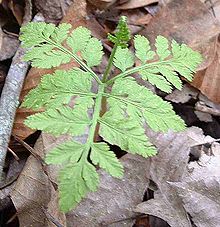- Botrychium
-
Moonwort 
Botrychium lunaria Scientific classification Kingdom: Plantae Division: Pteridophyta Class: Psilotopsida Order: Ophioglossales Family: Botrychiaceae Genus: Botrychium
Sw.Species Several, see text
Moonworts are ferns, seedless vascular plants, of the genus Botrychium, sensu stricto. They are small, with fleshy roots, and reproduce by spores shed into the air. One part of the leaf, the trophophore, is sterile and fernlike; the other, the sporophore, is fertile and carries the clusters of sporangia or spore cases. Some species only occasionally emerge above ground and gain most of their nourishment from an association with mycorrhizal fungi. They are unusual among tracheophytes ("higher plants") in that at least some species produce the sugar trehalose.
The circumscription of Botrychium is disputed between different authors; some botanists include the genera Botrypus and Sceptridium within Botrychium, while others treat them as distinct. The latter treatment is provisionally followed here.
Selected species
- Botrychium acuminatum[verification needed] – pointed moonwort
- Botrychium ascendens W.H.Wagner – upswept moonwort, triangle-lobed moonwort, upward-lobed moonwort
- Botrychium australe[1]
- Botrychium boreale[verification needed] – northern moonwort
- Botrychium campestre[verification needed] – prairie moonwort, prairie dunewort
- Botrychium crenulatum W.H.Wagner – crenulate moonwort
- Botrychium dissectum[2]
- Botrychium gallicomontanum[3]
- Botrychium hesperium[verification needed] – western moonwort
- Botrychium lanceolatum[verification needed] – lance-leaved grapefern, triangle moonwort, triangle grapefern
- Botrychium lineare[verification needed] – narrow-leaved grapefern
- Botrychium lunaria (L.) Sw. – common moonwort, grapefern moonwort
- Botrychium lunarioides.[4] – winter grapefern
- Botrychium matricariifolium[5] – daisy-leaved moonwort, matricary grapefern, matricary moonwort, chamomile grapefern
- Botrychium minganense Victorin – mingan's moonwort
- Botrychium montanum W.H.Wagner – mountain moonwort
- Botrychium mormo[3] – little goblin moonwort
- Botrychium multifidum[6]
- Botrychium paradoxum[verification needed] – peculiar moonwort
- Botrychium pedunculosum[verification needed] – stalked moonwort
- Botrychium pinnatum H. St.John – northern moonwort
- Botrychium pseudopinnatum[verification needed] – false northwestern moonwort, false daisy-leaved grapefern
- Botrychium simplex[verification needed] – little grapefern, least moonwort, least grapefern
- Botrychium socorrense[verification needed]
- Botrychium spathulatum[verification needed] – spatulate moonwort, Spoon-leaved moonwort
- Botrychium ternatum[verification needed]
- Botrychium tunux[verification needed]
- Botrychium × watertonense[verification needed]
- Botrychium yaaxudakeit[verification needed]
Conservation
Moonworts can be found in many environments, including prairies, forests, and mountains. While some Botrychium species are quite rare, conservation efforts can be difficult. Determining the rarity of a species is complicated by the plants’ small leaves, which stand only 2-10 centimeters above the soil.[3] Even more of a challenge in obtaining an accurate population count is the genus’s largely subterranean life cycle. The vast majority of any one population of moonworts actually exists below ground in banks consisting of several types of propagules. One type of propagule is the ungerminated spores, which must percolate through the soil beyond the reach of light in order to germinate. This presumably increases the probability that the spore will be in range of a mycorrhizal symbiont before it produces the tiny, roughly heart-shaped gametophyte, which also exists entirely below ground.[7] Finally, some species produce gemmae, a form of asexual propagation achieved by budding of the root.[3]
Juvenile and dormant sporophytes can also be hidden in the soil for long periods of time. Mature sporophytes do not necessarily produce a leaf annually; they can remain viable underground for up to 10 years without putting up a photosynthetic component. This feat is made possible by their dependence on symbiotic partnership with AM fungi of the genus Glomus, which supply most fixed carbon for growth and reproduction.[8]
This mycorrhizal dependence has also made lab cultivation of moonworts difficult. Thus far, only germination of the gametophyte has been successful.
References
- ^ Kelly, Dave (1994). "Demography and conservation of Botrychium australe, a peculiar, sparse mycorrhizal fern". New Zealand Journal of Botany 32: 393-400.
- ^ Montgomery, James D. (1990). "Survivorship and Predation Changes in Five Populations of Botrychium dissectum in Eastern Pennsylvania". American Fern Journal. 4 80: 173-182.
- ^ a b c d Johnson-Groh, C. L. and J. Lee (2002). “Phenology and demography of two species of Botrychium (Ophioglassaceae)”. American Journal of Botany 89 (10): 1624-1633.
- ^ Wagner, W. H. (1993). Flora of North America. New York: Oxford University Press. pp. 85-91.
- ^ Muller, S. (1992). "The impact of a drought in spring on the sporulation of Botrychium matricariifolium (Retz) A. Br. in the Bitcherland (Northern Vosges, France)". Acta Oecologia 13: 335-343.
- ^ Mesipuu, Meeli; R. P. Shefferson and T. Kull (2009). "Weather and herbivores influence fertility in teh endangered fern Botrychium multifidum (S.G. Gmel.) Rupr". Plant Ecology 203: 23-31.
- ^ Whittier D (1973). “The effect of light and other factors on spore germination in Botrychium dissectum”. Can J Bot 51: 1791-1794.
- ^ Winther J, Friedman W (2007). “Arbuscular mycorrhizal symbionts in Botrychium (Ophioglossaceae)”. Am J Bot 94 (7): 1248-1255.
- Botrychium in Flora of North America (incl. Botrypus)
Categories:
Wikimedia Foundation. 2010.

